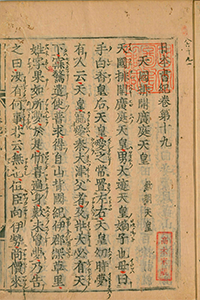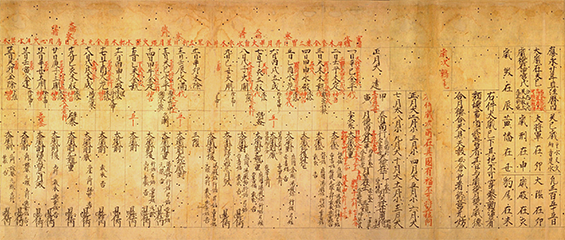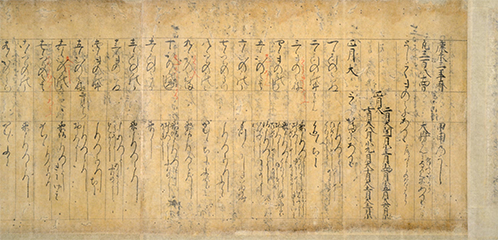- Top
- > Calendar History
- > Calendar History 1
Calendar History 1
The Source
Japan's first calendar came from China via Korea. In the middle of the 6th century, the Yamato Imperial Court, which ruled Japan at the time, invited a priest from a country called Paekche (Kudara in Japanese), in what is now Korea, to learn from him how to draw up a calendar, as well as astronomy and geography. Reportedly, Japan organized its first calendar in the 12th year of Suiko (604).
| Title | Creator | Physical data |
|---|---|---|
| Nihonshoki. Vol.19 | - | 1v. |
| Date | Publisher | Place |
| 1610 | - | - |
| Note | Subject(NDC) | Call No. |
| An old edition of type printing. | 210.3 | WA7-120 |
An entry dated June of the 14th year of Emperor Kinmei (553) in the Nihonshoki, Japan's oldest chronicle, states that the government planned to invite a calendar expert from Paekche to introduce a calendar to Japan, making it the first reference to a calendar in all Japanese records.
Back then, all matters relating to the calendar were determined by the Imperial Court. Under the Ritsuryosei system of centralized administration under the Ritsuryo legal code of the Taika Reformation, the Onmyoryo of Nakatsukasasho was in charge of the task. An Onmyoryo was a government office that had jurisdiction over calendar preparation, astronomy, divination, etc. It was a time when calendars and divination were inseparable. From the end of 10th century, the task of preparing the calendar was handed down in the Kamo family, while astronomy passed through generations of the Abe family, its patriarch being Abe Seimei (921-1005), noted as an Onmyo-shi, or specialist in the realm of calendars and divination.
"Tai-in-taiyo-reki"
The calendar used then was called "Tai-in-taiyo-reki," a lunisolar calendar, or "Onmyo-reki."
Each month was adjusted to the cycle of moon's waxing and waning. Since the moon orbits the earth in about 29.5 days, adjustment was required and this was done by making months with either 30 days or 29 days, the former, "Dai-no-tsuki (long month)," the latter, "Sho-no-tsuki (short month)." Aside from the moon's orbit round the earth, the earth orbits the sun in 365.25 days, which, as we all know, causes the seasonal changes. Thus, merely repeating long and short months gradually produced a discrepancy between the actual season and the calendar. To compensate for this, a month called "Uru-zuki," or intercalary month, was inserted every few years to produce a year with 13 months, with the order of longer and shorter months changing year by year.
Unlike our contemporary calendar in which there is no change in the order of months, back then the fixing of a calendar was deemed so important that it was placed under the control of the imperial court and, in the later Edo period, under the superimposed military shogunate regime.
Spread of the Guchu-reki and Kana-goyomi calendars
The calendar established by Onmyo-ryo was called "Guchu-reki," one in which various words indicating seasons, annual events and daily good omens were written in Chinese characters and called "Reki-chu (calendar notes)." The Guchu-reki derives its name from the fact that the notes were written in detail.
This Guchu-reki, which was in service until the Edo period, was used particularly by noblemen in ancient and medieval times, individuals based their everyday activities on the calendar. They often wrote a personal diary in the blank spaces or on the back of their personal calendar. These entries remain left valuable historical records of the era.
| Title | Creator | Physical data |
|---|---|---|
| 20th year of O-ei (1413) Guchu-reki (Mansai Jugo nikki) | - | 1 scroll |
| Date | Publisher | Place |
| - | - | - |
| Note | Subject(NDC) | Call No. |
| On verso: Mansai Jugo nikki (the diary of Mansai Jugo) | 499.81/210.46 | WA1-1 |
This is a Guchu calendar made in the 20th year of O-ei (1413), on the back of which is a diary written by Mansai Jugo (1376-1435), the high priest of the Daigoji Temple, upon whom the emperor conferred the lofty rank of "Jusango." He was highly regarded and taken into the confidence of three Muromachi shoguns, Ashikaga Yoshimitsu, Ashikaga Yoshomichi and Ashikaga Yoshimasa, and known as the "Priest in Black." His diary is treasured as a historical record giving an insight into the political affairs of the era.
With the spread of kana, Japan's phonetic alphabet, "Kana-goyomi," a simplified edition of Guchu-reki written in kana, appeared. In the middle of the 14th century calendars started to be printed and soon reached a broader range of users.
| Title | Creator | Physical data |
|---|---|---|
| 3rd year of Koei (1344) Kana-goyomi (Moromor-ki. Vol.16) | - | 1 scroll |
| Date | Publisher | Place |
| - | - | - |
| Note | Subject(NDC) | Call No. |
| On verso: Moromori-ki (The diary of Nakahara Moromori) | 449.81/210.45 | WA27-1 |
On the back of a Kana-goyomi of the 3rd year of Koei (1344) was the diary of Nakahara Moromori (dates unknown), an official of the imperial court.






